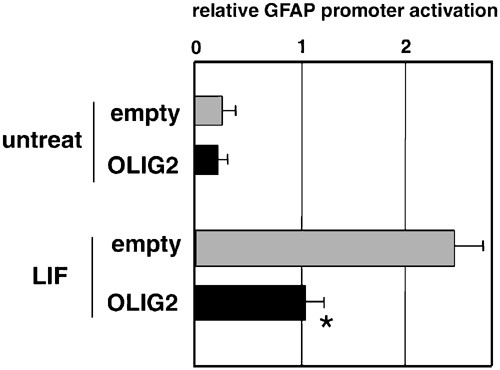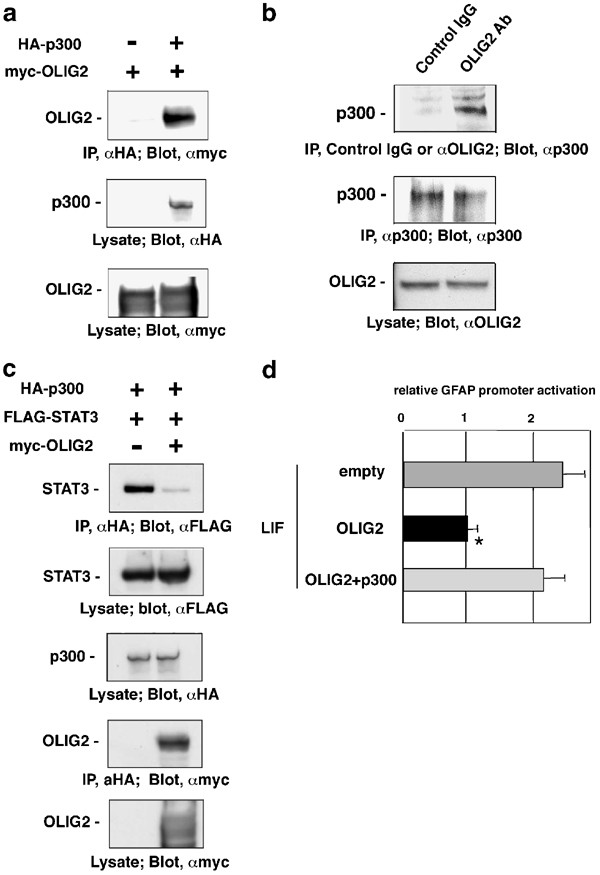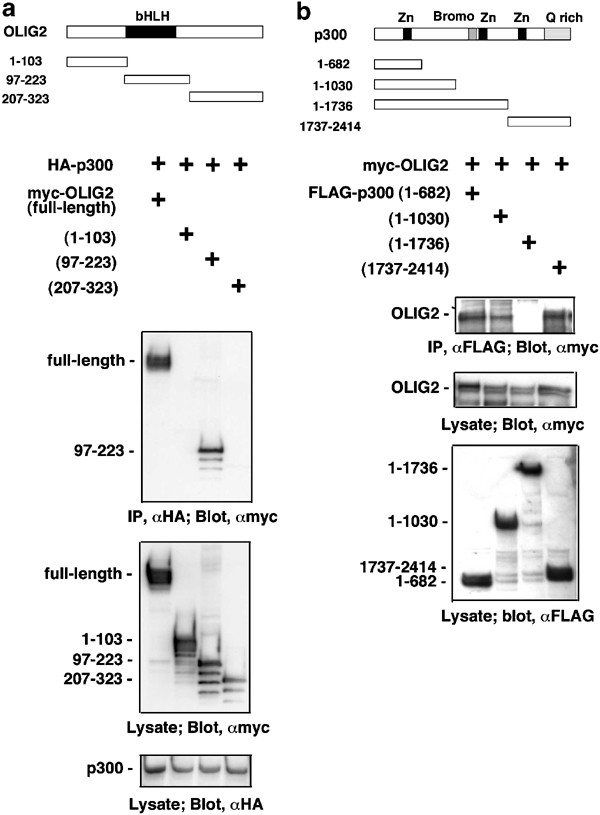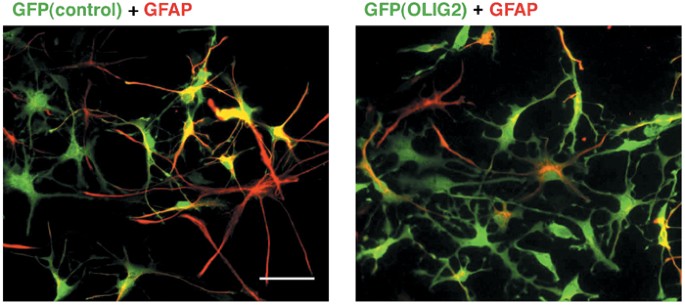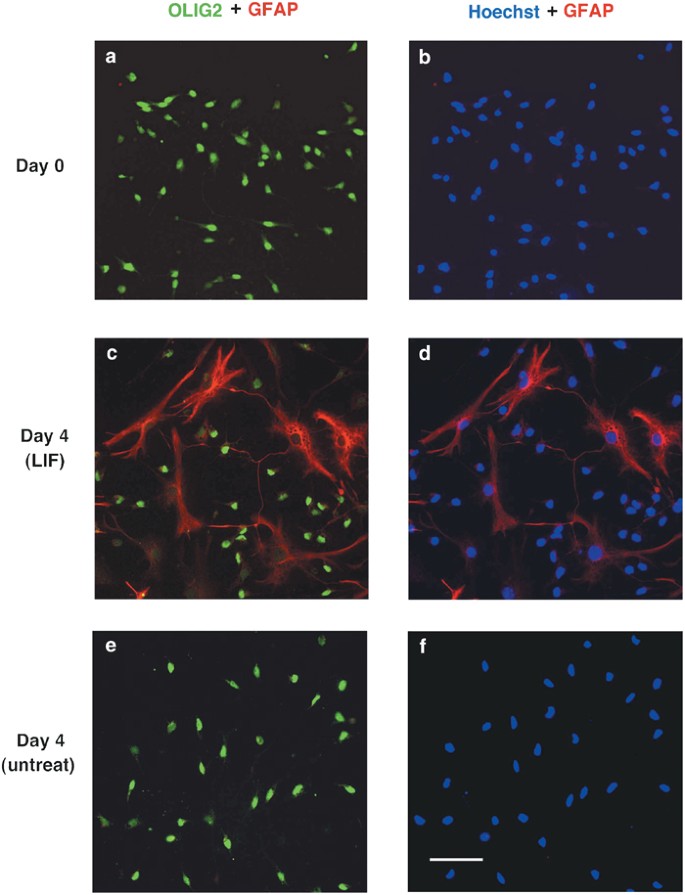Negative regulatory effect of an oligodendrocytic bHLH factor OLIG2 on the astrocytic differentiation pathway (original) (raw)
Introduction
Mouse fetal telencephalic neuroepithelial cells give rise to neurons, astrocytes and oligodendrocytes,1,2,3 whose differentiation is thought to be regulated by cell-external cues and cell-intrinsic programs.4,5 One of such cell-external cues is interleukin-6 (IL-6) family of cytokines that have various biological effects on cell growth, differentiation and survival in multiple cell types.6 IL-6 and members of this family, that is, IL-11, leukemia inhibitory factor (LIF), ciliary neurotrophic factor, oncostatin M, cardiotrophin-1 and cardiotrophin-like cytokine, are pleiotropic and display overlapping functions. For example, all of them have a potential to induce astrocytic differentiation from neuroepithelial cells, which involves activation of a downstream transcription factor signal transducer and activator of transcription (STAT3).7,8,9,10,11,12
In the nervous system, bone morphogenetic protein 2 (BMP2), a member of the transforming growth factor-β superfamily, is also involved in astrocytic differentiation.8,13 BMP2-induced heterodimerization of its receptors activates downstream transcription factors Smad1, -5 and -8, and these Smad proteins interact with the common Smad, Smad4. Similar to STAT3, activated Smad proteins also translocate to the nucleus and activates specific target genes.14
Previously, we have shown that two cytokines, LIF and BMP2, act in synergy on primary fetal neural progenitor cells to induce astrocytes.8 These cytokines activate respective downstream transcription factors, STAT3 and Smad1, which are bridged by a transcriptional coactivator p300 in the nucleus. The formation of this ternary complex is prerequisite for the differentiation of glial fibrillary acidic protein (GFAP)-positive astrocytes from undifferentiated neuroepithelial cells.
In addition to these transcriptional regulators, various members of the basic helix–loop–helix (bHLH) protein family also play essential roles in the generation of specific subsets of neurons.15,16,17,18 Two bHLH transcription factors, OLIG1 and OLIG2, were identified as proteins regulating oligodendrocyte development.19,20,21 OLIG2 has also been shown to play an essential role in the generation of motor neurons.21,22,23 Interestingly, in mice deficient for both OLIG1 and OLIG2, astrocytes came out ectopically in the region of ventral spinal cord where OLIG2 is normally expressed.24 These results raised a possibility that OLIG2 and/or OLIG1 may have a negative regulatory effect on astrocytic development.
We here show that OLIG2 has inhibitory effects on astrocytic differentiation and that OLIG2 prevents formation of the STAT3-p300 complex that is known to be required for the development of astrocytes. Finding of the anti-astrocytic property of oligodendrocytic factor OLIG2 suggests the presence of a negative interaction between astrocytic and oligodendrocytic differentiation pathways.
Results
OLIG2 represses GFAP gene transcription in neuroepithelial cells
We wanted to know whether an oligodendrocytic transcription factor OLIG2 has a potential to inhibit astrocytic differentiation. We first examined whether OLIG2 could suppress the expression of an astrocyte-specific protein, GFAP. Neuroepithelial cells were transfected with a GFAP promoter-luciferase reporter vector together with or without an OLIG2 expression vector, and then stimulated with LIF, which is known to induce astrocytic differentiation. As shown in Figure 1, LIF stimulation induced transcriptional activation of the GFAP promoter. By contrast, forced expression of OLIG2 significantly suppressed this activation. OLIG2 did not exhibit negative effect on a promoter for elongation factor 1_α_ in the internal control plasmid, pEF-Rluc (data not shown). These results suggest that OLIG2 can specifically block the expression of GFAP at the transcriptional level.
Figure 1
Inhibition of GFAP promoter activation by OLIG2. Neuroepithelial cells were transfected with GF1L-pGL3 and pEF-Rluc, together with pCMV-HA (control vector; gray bars) or HA-OLIG2-pCMV (OLIG2 vector; black bars) as indicated. After 16 h incubation, cells were either untreated or treated with 80 ng/ml of LIF for 8 h and solubilized. The activity of firefly luciferase was normalized with sea pansy luciferase. An asterisk means statistical significance from the control by Student's _t_-test (P<0.02)
OLIG2 binds to p300 and abolishes the complex formation between STAT3 and p300
Since we have previously shown that LIF stimulation activates STAT3 and allows it to form a complex with p300 in the nucleus, which is essential for GFAP expression,8 we hypothesized that OLIG2 could interfere with this association, leading to the inhibition of GFAP expression. We wanted to know whether OLIG2 interferes with physical association between STAT3 and p300. We first investigated whether OLIG2 could interact directly with either STAT3 or p300. As shown in Figure 2a, when epitope-tagged OLIG2 and p300 were coexpressed in COS-7 cells, OLIG2 was coimmunoprecipitated with p300 (Figure 2a). Interaction between OLIG2 and STAT3 was not observed (data not shown). To exclude the possibility that the association between OLIG2 and p300 is a consequence of overexpression, we examined whether this association occurs in the fetal telencephalic neuroepithelial cells. As shown in Figure 2b, endogenous p300 protein was found to associate with endogenous OLIG2 protein in the neuroepithelial cells. These results indicate that OLIG2 binds to p300 in vivo and suggest that OLIG2 may have an inhibitory effect on the STAT3-p300 complex formation. To examine this possibility, p300 and STAT3 were coexpressed either in the absence or presence of OLIG2 in COS-7 cells. In the absence of OLIG2, STAT3 was coimmunoprecipitated with p300 (Figure 2c, left lane). By contrast, in the presence of OLIG2, the interaction between STAT3 and p300 was clearly inhibited (Figure 2c, right lane). These results suggest that OLIG2 can block GFAP gene expression by sequestering p300 from STAT3. Thus, we hypothesized that the inhibition of LIF-induced GFAP gene expression by OLIG2 in Figure 1 could be recovered by forced expression of p300. As shown in Figure 2d, the expression of p300 relieved LIF-induced GFAP promoter activation from OLIG2-mediated inhibition.
Figure 2
Inhibitory effect of OLIG2 protein on the formation of the STAT3-p300 complex. (a) COS-7 cells were transfected with 6myc-OLIG2-pcDNA3, together with either HA-p300-BOSE or empty vector, as shown on top. After 24 h incubation, cell lysates were subjected to immunoprecipitation. Immunocomplexes were analyzed by standard SDS-PAGE and Western blotting methods, using antibodies to respective tags. (b) Whole-cell lysates of neuroepithelial cells were subdivided into two tubes and immunoprecipitated with either normal rabbit IgG (control, left lane) or affinity purified anti-OLIG2 antibody (right lane). Immunoprecipitates were analyzed using anti-p300 antibody. (c) COS-7 cells were transfected with HA-p300-BOSE and FLAG-STAT3-BOSE, together with either 6myc-OLIG2-pcDNA3 or empty vector, and analyzed as in (a). (d) Transfection was performed as in Figure 1 except that HA-p300-pCMV_β_ was also used (light gray bar). The amount of empty vector included in each transfection was adjusted so that the total amount of the plasmids becomes even. After treatment with LIF for 8 h, luciferase activity was measured
A region containing the bHLH motif in OLIG2 and both N- and C-termini of p300 are involved in the physical association between OLIG2 and p300
To understand the interaction between OLIG2 and p300 in more detail, we mapped protein–protein-interaction domains using deletion constructs. When OLIG2 mutants and a full-length p300 were coexpressed in COS-7 cells, the middle region of OLIG2 (97–223 amino acids) that contains the bHLH domain was found to bind to p300, whereas either N- or C-terminal fragments of OLIG2 did not (Figure 3a). This result is reminiscent of previous findings that the bHLH motif in transcription factors, MyoD and BETA2/NeuroD1, interacted with p300.25,26 It might thus be possible that a bHLH region in some transcription factors may generally interact with p300. In our experimental system, however, forced expression of only the middle region of OLIG2 could not inhibit LIF-induced GFAP promoter activation (data not shown), suggesting that other regions of OLIG2 is also involved in the execution of inhibitory function of OLIG2. We observed extensive protein degradation of the OLIG2 deletion constructs in COS-7 cells, which did not occur in the case of full-length OLIG2 (Figure 3a). The reason how this happened remains unknown. The instability of the OLIG2 fragments might affect the transcriptional repression capability of the OLIG2 deletion mutants.
Figure 3
Mapping of the regions responsible for the binding between OLIG2 and p300. (A) Series of plasmids that express myc-tagged OLIG2 deletion mutants and HA-p300-BOSE were introduced into COS-7 cells, and analyzed as in Figure 2. (B) Deletion mutants of FLAG-tagged p300 were tested for its binding activity to myc-tagged full-length OLIG2. Mouse anti-FLAG monoclonal antibody was used for immunoprecipitation. Zn: zinc-finger motif; Bromo: bromodomain; Q-rich: glutamine-rich region
We then examined which region in the p300 protein interacts with OLIG2. From the experiment with p300 deletion mutants and full-length OLIG2 expressed in COS-7 cells, we concluded that both N- and C-termini of p300 had a potential to interact with OLIG2 (Figure 3b). Similar binding property was observed in the association between STAT3 and p300, in which both N- and C-termini of p300 interacted with STAT3, although the former showed higher affinity.8 It is of interest to note that transcription factors SF-1 and Ets-1 can also bind to both N- and C-termini of p300.27,28 The fragment of p300 spanning 1–1736 amino-acid residues did not bind to OLIG2 (Figure 3b, lane 3), which implies that the region between residues 1030 and 1736 may inhibit the interaction by masking the N-terminally located OLIG2-interaction domain.
Enforced expression of OLIG2 inhibits astrocytic differentiation
To examine whether OLIG2 can block astrocytic differentiation, we produced a recombinant OLIG2 retrovirus that encodes both OLIG2 and green fluorescent protein (GFP) genes. Neuroepithelial cells were infected with either a control virus encoding GFP alone or the OLIG2 virus, and then cultured for 4 days with or without LIF. Coexpression of HA-tagged OLIG2 and GFP within a single OLIG2 virus-infected neuroepithelial cell by internal ribosome entry site (IRES) was confirmed by immunocytochemistry using anti-HA monoclonal antibody and anti-GFP polyclonal antibody (data not shown). In the absence of LIF, cells infected with either the control or the OLIG2 viruses were GFAP negative (data not shown). In the presence of LIF, 32±6% of the control virus-infected GFP-expressing cells were positive for GFAP (Figure 4, left panel). By contrast, only 22±4% of the OLIG2 virus-infected GFP-expressing cells were GFAP positive (Figure 4, right panel). The difference between these two percentages was statistically significant by the Student's _t_-test (P<0.02). The result suggests that OLIG2 can inhibit astrocytic differentiation. In the presence of LIF, the proportion of microtubule-associated protein 2 (MAP2)-positive cells in the OLIG2 virus-infected cells (8±2%) was not significantly different from that in the control virus-infected cells (7±3%). Under the same culture condition, platelet-derived growth factor receptor α chain (PDGF receptor α chain)-positive cells were not emerged from neuroepithelial cells infected with either the control virus or the OLIG2 virus (data not shown).
Figure 4
Effect of forced expression of OLIG2 on astrocytic differentiation. Neuroepithelial cells were infected with a recombinant retrovirus that encodes both OLIG2 and GFP (right panel). A retrovirus that encodes GFP alone was used as a control (left panel). At 24 h after infection, the medium was replaced with the fresh medium containing 80 ng/ml of LIF. After 4 days, cells were fixed and stained with anti-GFP polyclonal antibody (green) and anti-GFAP monoclonal antibody (red). Scale bar, 30 _μ_m
Endogenous OLIG2 protein disappears from the nucleus in differentiated astrocytes
Now, it is consistent that a single multipotent neural stem cell can generate neurospheres in the presence of basic fibroblast growth factor (bFGF) and differentiate into oligodendrocytes and astrocytes, as well as neurons.29 The results described above raise a question whether expression levels of OLIG2 are downregulated during astrocytic differentiation. To answer this question, we examined the expression of OLIG2 in neuroepithelial cells by immunocytochemistry. Neuroepithelial cells which had been cultured for 4 days were replated on chamber slides and stained with anti-OLIG2 antibody.21 As shown in Figure 5a and b, we found that nuclei of 91±2% the cell population were positive for OLIG2 on the following day of replating on chamber slides just prior to LIF stimulation (day 0, Figure 5a and b). To examine the relationship between OLIG2 and GFAP expression, these cells were cultured with or without LIF, and stained with anti-OLIG2 and anti-GFAP antibodies. When the cells were treated with LIF for 4 days, 30±6% of cells were positive for the expression of GFAP, and these cells showed negligible OLIG2 immunoreactivity in their nuclei, in marked contrast to GFAP-negative cells (Figure 5c and d). In cells cultured without LIF for 4 days, GFAP-positive cells were barely detectable, and such cells, if any, expressed OLIG2 in their nuclei, whose level was comparable to that of GFAP definitely negative cells (Figure 5e and f). These results indicated that downregulation of OLIG2 expression is presumably necessary for neuroepithelial cells to undergo astrocytic differentiation in culture.
Figure 5
Disappearance of OLIG2 protein from the nucleus in differentiated astrocytes. Neuroepithelial cells were plated on precoated 8-well chamber slides. On the following day, the medium was replaced (day 0) and cultured for further 4 days in the presence (c, d) or absence (e, f) of 80 ng/ml LIF. (a, c, e) Cells were fixed as indicated, and double labeled with anti-OLIG2 polyclonal antibody (green) and anti-GFAP monoclonal antibody (red). (b, d, f) Hoechst nuclear staining views (blue) of the same fields in (a, c, e), respectively, were merged with the images of the GFAP staining. Scale bar, 30 m
Discussion
A large number of transcription factors have been found to regulate neural cell fates, either positively or negatively, and some of them can induce differentiation of one cell lineage while inhibiting another. We and others have shown that a reciprocal mechanism operates between neurogenesis and astrocytogenesis: BMP2 induces the development of astrocytes, and at the same time suppresses neurogenesis by inhibiting neurogenic bHLH transcription factors via the expression of Id1, Id3 and Hes-5 proteins.30 By contrast, a bHLH transcription factor neurogenin (Ngn1) promotes neurogenesis, and at the same time inhibits astrocytogenesis by inhibiting STAT3.31 Here, we have shown a novel negative interaction between astrocytic and oligodendrocytic differentiation signals: OLIG2, which was originally thought to be involved in the development of motor neurons and oligodendrocytes, also blocks astrocytogenesis by inhibiting complex formation between p300 and STAT3. This finding of the dual function of OLIG2 in gliogenesis is consistent with the observation that astrocytes are ectopically generated instead of oligodendrocytes in the spinal cord of OLIG1/2 double knockout mice.24 Incompleteness in the inhibition of astrocytic differentiation by OLIG2 overexpression may partly be because OLIG2 requires a cooperative factor (or factors) for full inhibitory activity, which might include OLIG1. Recently, another astrocytic differentiation cytokine, BMP4, was shown to inhibit the expression of OLIG2.32 This finding also supports the idea of the presence of mutual negative interactions between astrocytic and oligodendrocytic differentiation pathways. As we showed previously,8 a BMP2 downstream transcription factor Smad1 forms a complex with STAT3 and p300. No physical interaction between Smad1 and OLIG2 was observed (data not shown), but the effects of OLIG2 on the Smad1-p300 complex formation remains to be elucidated.
The present results showing the interaction of OLIG2 with a transcriptional coactivator p300 raise a possibility that OLIG2 may function as a transcriptional activator in neural cell development. However, this seems unlikely since a previous report showed that the bHLH domain of OLIG2 fused to the VP16 transactivation domain significantly inhibited motor neuron development.23 We suppose that OLIG2 would have two distinct aspects as a transcriptional repressor, that is, transcriptional suppression by recruiting an unidentified corepressor protein complex and by sequestering coactivator p300.
In vivo, OLIG2 is expressed in the restricted bilateral ventral regions of the neural tube from which motor neurons and oligodendrocytes are generated. It should be noted, however, that once the neuroepithelium is triturated and cultured on a dish, almost all neuroepithelial cells express OLIG2 (Figure 5a and b), indicating that they might acquire a potential to differentiate into oligodendrocytes in vitro. Dissociation process or monolayer culture with bFGF may affect some regulatory elements that control OLIG2 expression. When the neuroepithelial cells were cultured in the absence of bFGF with 0.1% fetal calf serum (FCS) for 7 days, 48±3, 20±4, 9±2% of the cells were immunolabeled for MAP2, GFAP and galactocerebroside, respectively (data not shown). This fact indicates that OLIG2 expression is not sufficient to initiate and progress the oligodendrocytic differentiation pathway in cultured neuroepithelial cells and that some other factors, such as Nkx2.2, should cooperate as reported previously.33 Further investigations that identify upstream regulatory elements/factors or binding proteins of OLIG2 would provide valuable clues for fully understanding the role of OLIG2. In addition, these studies would also be of much importance in elucidating the transcription factor network that determines the fate of cells in the developing central nervous system.
Materials and Methods
Cell culture
Time-pregnant ICR mice were treated according to the guidelines of Kumamoto University Center for Animal Resources and Development. Neuroepithelial cells were isolated from telencephalons of E14.5 mice and expanded for 4 days in N2-supplemented DMEM/F-12 containing 10 ng/ml basic fibroblast growth factor (bFGF) as described previously.8 Cells were then detached and used for further experiments. Mouse LIF (ESGRO, Invitrogen) was used for the induction of astrocytes at a concentration of 80 ng/ml. COS-7 cells were maintained in DMEM supplemented with 10% FCS. A retrovirus packaging cell line, Plat-E, was maintained in DMEM supplemented with 10% FCS, 10 _μ_g/ml of blasticidin and 1 _μ_g/ml of puromycin.34
Plasmid constructions
cDNA for mouse OLIG2 was amplified by reverse transcription and polymerase chain reaction (RT-PCR) using Superscript First Strand Synthesis System for RT-PCR (Invitrogen) and Pfu Turbo DNA polymerase (STRATAGENE). Total RNA was isolated by ISOGEN (Nippongene) from mouse neuroepithelial cells and used as a template in RT-PCR. The obtained cDNA was inserted into pcDNA3 (Invitrogen) and pCMV-HA (CLONTECH), resulting in 6myc-OLIG2-pcDNA3 and HA-OLIG2-pCMV, respectively. OLIG2 deletion mutants (N-terminus, 1–103 residues; middle region, 97–223 residues; C-terminus, 207–323 residues) were made by a standard subcloning procedure. Firefly luciferase reporter plasmid driven by the 2.5 kb GFAP gene promoter (GF1L-pGL3), sea pansy luciferase plasmid (pEF-Rluc), expression plasmids of STAT3 (FLAG-STAT3-BOSE), full-length p300 (HA-p300-pCMVβ and HA-p300-BOSE) and a series of FLAG-tagged p300 deletion mutant plasmids were described previously.8
Reporter assay
Neuroepithelial cells, which had been cultured for 4 days with bFGF, were replated on 24-well plates the day before the transfection. Cells were transfected with the reporter plasmid, GF1L-pGL3, and internal control plasmid, pEF-Rluc, together with the expression plasmids as described in figure legends using TransIT-LT1 (Mirus). On the following day, LIF was added to the medium at a concentration of 80 ng/ml, and cells were incubated for 8 h. Luciferase activity was measured using Pikkagene Dual Luciferase Assay System (Tokyo Ink Inc.).
Immunoprecipitation
COS-7 cells were plated on 60 mm dishes. On the following day, cells were transfected with the expression plasmids using TransIT-LT1. After 24 h incubation, cells were solubilized in NP40 lysis buffer (10 mM Tris at pH 7.5, 150 mM NaCl, 0.5% NP40, 5 mM EDTA, 5 mg/ml aprotinine and 3 mM pAPMSF) and cell lysates were cleared by centrifugation. The lysates were subjected to immunoprecipitation with rabbit anti-HA antibody (Santa Cruz, Y-11). Immunocomplexes were analyzed by standard SDS-PAGE and Western blotting methods using anti-HA antibody, mouse anti-FLAG antibody (Sigma, M2) and mouse anti-myc antibody (UPSTATE, 9E10). To detect the interaction between endogenous OLIG2 and p300 proteins, neuroepithelial cells expanded for 4 days were plated on 60 mm dishes and cultured for further 2 days in the presence of bFGF. Whole-cell lysates were prepared in NP40 lysis buffer using closed-type sonicator (COSMO BIO) and immunoprecipitated with either normal rabbit IgG (Santa Cruz, sc-2027) or affinity purified anti-OLIG2 antibody.21 Immunoprecipitates were analyzed using anti-p300 antibody (Santa Cruz, C-20).
Immunocytochemistry
Neuroepithelial cells replated on 8-well chamber slides were fixed in 4% paraformaldehyde and preincubated in blocking solution (PBS containing 10% FCS and 0.1% Triton X-100). Then cells were double stained with mouse anti-GFAP antibody (Sigma, G3893) and rabbit anti-GFP antibody (MBL, 598) diluted in the blocking solution. Anti-MAP2 monoclonal antibody (Simga, M4403) and anti-PDGF receptor α chain (BD Pharmingen, 558774) were also used. Nuclei were stained using Hoechst 33258 (nacalai tesque).
Retroviral production
For the recombinant retrovirus construction, cDNA for OLIG2 was inserted into pMY-IRES-GFP34 and the plasmid was introduced into Plat-E using TransIT-293 (Mirus). After 48 h incubation, culture medium containing produced recombinant retroviruses was centrifuged, and the collected viruses were resuspended in N2-supplemented DMEM/F-12 containing 10 ng/ml bFGF.
Abbreviations
STAT3:
signal transducer and activator of transcription 3
LIF:
leukemia inhibitory factor
GFAP:
glial fibrillary acidic protein
bHLH:
basic helix–loop–helix
GFP:
green fluorescent protein
bFGF:
basic fibroblast growth factor
References
- Anderson DJ (2001) Stem cells and pattern formation in the nervous system: the possible versus the actual. Neuron 30: 19–35
Article CAS PubMed Google Scholar - Gage FH (2000) Mammalian neural stem cells. Science 287: 1433–1438
Article CAS PubMed Google Scholar - McKay R (1997) Stem cells in the central nervous system. Science 276: 66–71
Article CAS PubMed Google Scholar - Edlund T and Jessell TM (1999) Progression from extrinsic to intrinsic signaling in cell fate specification: a view from the nervous system. Cell 96: 211–224
Article CAS PubMed Google Scholar - Nakashima K and Taga T (2002) Mechanisms underlying cytokine-mediated cell-fate regulation in the nervous system. Mol. Neurobiol. 25: 233–244
Article CAS PubMed Google Scholar - Taga T and Kishimoto T (1997) Gp130 and the interleukin-6 family of cytokines. Annu. Rev. Immunol. 15: 797–819
Article CAS PubMed Google Scholar - Bonni A, Sun Y, Nadal-Vicens M, Bhatt A, Frank DA, Rozovsky I, Stahl N, Yancopoulos GD and Greenberg ME (1997) Regulation of gliogenesis in the central nervous system by the JAK-STAT signaling pathway. Science 278: 477–483
Article CAS PubMed Google Scholar - Nakashima K, Yanagisawa M, Arakawa H, Kimura N, Hisatsune T, Kawabata M, Miyazono K and Taga T (1999) Synergistic signaling in fetal brain by STAT3-Smad1 complex bridged by p300. Science 284: 479–482
Article CAS PubMed Google Scholar - Yanagisawa M, Nakashima K and Taga T (1999) STAT3-mediated astrocyte differentiation from mouse fetal neuroepithelial cells by mouse oncostatin M. Neurosci. Lett. 269: 169–172
Article CAS PubMed Google Scholar - Yanagisawa M, Nakashima K, Arakawa H, Ikenaka K, Yoshida K, Kishimoto T, Hisatsune T and Taga T (2000) Astrocyte differentiation of fetal neuroepithelial cells by interleukin-11 via activation of a common cytokine signal transducer, gp130, and a transcription factor, STAT3. J. Neurochem. 74: 1498–1504
Article CAS PubMed Google Scholar - Ochiai W, Yanagisawa M, Takizawa T, Nakashima K and Taga T (2001) Astrocyte differentiation of fetal neuroepithelial cells involving cardiotrophin-1-induced activation of STAT3. Cytokine 14: 264–271
Article CAS PubMed Google Scholar - Uemura A, Takizawa T, Ochiai W, Yanagisawa M, Nakashima K and Taga T (2002) Cardiotrophin-like cytokine induces astrocyte differentiation of fetal neuroepithelial cells via activation of STAT3. Cytokine 18: 1–7
Article CAS PubMed Google Scholar - Gross RE, Mehler MF, Mabie PC, Zang Z, Santschi L and Kessler JA (1996) Bone morphogenetic proteins promote astroglial lineage commitment by mammalian subventricular zone progenitor cells. Neuron 17: 595–606
Article CAS PubMed Google Scholar - Massague J and Chen YG (2000) Controlling TGF-beta signaling. Genes Dev. 14: 627–644
CAS PubMed Google Scholar - Guillemot F, Lo LC, Johnson JE, Auerbach A, Anderson DJ and Joyner AL (1993) Mammalian achaete-scute homolog 1 is required for the early development of olfactory and autonomic neurons. Cell 75: 463–476
Article CAS PubMed Google Scholar - Ben-Arie N, Bellen HJ, Armstrong DL, McCall AE, Gordadze PR, Guo Q, Matzuk MM and Zoghbi HY (1997) Math1 is essential for genesis of cerebellar granule neurons. Nature 390: 169–172
Article CAS PubMed Google Scholar - Ma Q, Chen Z, del Barco Barrantes I, de la Pompa JL and Anderson DJ (1998) Neurogenin1 is essential for the determination of neuronal precursors for proximal cranial sensory ganglia. Neuron 20: 469–482
Article CAS PubMed Google Scholar - Fode C, Gradwohl G, Morin X, Dierich A, LeMeur M, Goridis C and Guillemot F (1998) The bHLH protein NEUROGENIN 2 is a determination factor for epibranchial placode-derived sensory neurons. Neuron 20: 483–494
Article CAS PubMed Google Scholar - Lu QR, Yuk D, Alberta JA, Zhu Z, Pawlitzky I, Chan J, McMahon AP, Stiles CD and Rowitch DH (2000) Sonic hedgehog-regulated oligodendrocyte lineage genes encoding bHLH proteins in the mammalian central nervous system. Neuron 25: 317–329
Article CAS PubMed Google Scholar - Zhou Q, Wang S and Anderson DJ (2000) Identification of a novel family of oligodendrocyte lineage-specific basic helix–loop–helix transcription factors. Neuron 25: 331–343
Article CAS PubMed Google Scholar - Takebayashi H, Yoshida S, Sugimori M, Kosako H, Kominami R, Nakafuku M and Nabeshima Y (2000) Dynamic expression of basic helix–loop–helix Olig family members: implication of Olig2 in neuron and oligodendrocyte differentiation and identification of a new member, Olig3. Mech. Dev. 99: 143–148
Article CAS PubMed Google Scholar - Mizuguchi R, Sugimori M, Takebayashi H, Kosako H, Nagao M, Yoshida S, Nabeshima Y, Shimamura K and Nakafuku M (2001) Combinatorial roles of Olig2 and Neurogenin2 in the coordinated induction of pan-neuronal and subtype-specific properties of motoneurons. Neuron 31: 757–771
Article CAS PubMed Google Scholar - Novitch BG, Chen AI and Jessell TM (2001) Coordinate regulation of motor neuron subtype identity and pan-neuronal properties by the bHLH repressor Olig2. Neuron 31: 773–789
Article CAS PubMed Google Scholar - Zhou Q and Anderson DJ (2002) The bHLH transcription factors OLIG2 and OLIG1 couple neuronal and glial subtype specification. Cell 109: 61–73
Article CAS PubMed Google Scholar - Eckner R, Yao TP, Oldread E and Livingston DM (1996) Interaction and functional collaboration of p300/CBP and bHLH proteins in muscle and B-cell differentiation. Genes Dev. 10: 2478–2490
Article CAS PubMed Google Scholar - Mutoh H, Naya FJ, Tsai MJ and Leiter AB (1998) The basic helix–loop–helix protein BETA2 interacts with p300 to coordinate differentiation of secretin-expressing enteroendocrine cells. Genes Dev. 12: 820–830
Article CAS PubMed PubMed Central Google Scholar - Monte D, DeWitte F and Hum DW (1998) Regulation of the human P450scc gene by steroidogenic factor 1 is mediated by CBP/p300. J. Biol. Chem. 273: 4585–4591
Article CAS PubMed Google Scholar - Yang C, Shapiro LH, Rivera M, Kumar A and Brindle PK (1998) A role for CREB binding protein and p300 transcriptional coactivators in Ets-1 transactivation functions. Mol. Cell. Biol. 18: 2218–2229
Article CAS PubMed PubMed Central Google Scholar - Temple S (2001) The development of neural stem cells. Nature 414: 112–117
Article CAS PubMed Google Scholar - Nakashima K, Takizawa T, Ochiai W, Yanagisawa M, Hisatsune T, Nakafuku M, Miyazono K, Kishimoto T, Kageyama R and Taga T (2001) BMP2-mediated alteration in the developmental pathway of fetal mouse brain cells from neurogenesis to astrocytogenesis. Proc. Natl. Acad. Sci. USA 98: 5868–5873
Article CAS PubMed PubMed Central Google Scholar - Sun Y, Nadal-Vicens M, Misono S, Lin MZ, Zubiaga A, Hua X, Fan G and Greenberg ME (2001) Neurogenin promotes neurogenesis and inhibits glial differentiation by independent mechanisms. Cell 104: 365–376
Article CAS PubMed Google Scholar - Mekki-Dauriac S, Agius E, Kan P and Cochard P (2002) Bone morphogenetic proteins negatively control oligodendrocyte precursor specification in the chick spinal cord. Development 129: 5117–5130
CAS PubMed Google Scholar - Zhou Q, Choi G and Anderson DJ (2001) The bHLH transcription factor Olig2 promotes oligodendrocyte differentiation in collaboration with Nkx2.2. Neuron 31: 791–807
Article CAS PubMed Google Scholar - Morita S, Kojima T and Kitamura T (2000) Plat-E: an efficient and stable system for transient packaging of retroviruses. Gene Therapy 7: 1063–1066
Article CAS PubMed Google Scholar
Acknowledgements
We thank Dr. K Ikenaka for helpful discussion and Dr. M Raff for critical reading of the manuscript. We also thank Dr. T Kitamura for Plat-E cells, and members of our laboratory for valuable discussions and technical advice. We are very grateful to Ms. Y Noguchi for her secretarial assistance, and also thank Ms. K Kaneko and Ms. Y Saiki for technical help. This work was supported in part by grant-in-aid for 21st Century COE Research from Ministry of Education, Science and Culture ‘Cell Fate Regulation Research and Education Unit’; Scientific Research (B); Specially Promoted Research from the Ministry of Education, Culture, Science, Sports and Technology; Nakajima Foundation; Uehara Memorial Foundation; Japan Brain Foundation; Higo Foundation; Human Frontier Science Program; and the Virtual Research Institute of Aging of Nippon Boehringer Ingelheim.
Author information
Author notes
- T Kondo
Present address: Centre for Brain Repair, University of Cambridge, The E.D. Adrian Building, Forvie Site, Robinson Way, Cambridge, CB2 2PY, UK - S Fukuda and T Kondo: These two authors contributed equally to this work.
Authors and Affiliations
- Department of Cell Fate Modulation, Institute of Molecular Embryology and Genetics, Kumamoto University, Japan
S Fukuda, T Kondo & T Taga - The 21st Century COE Program ‘Cell Fate Regulation Research and Education Unit’, Kumamoto University, Kumamoto, 860-0811, Japan
S Fukuda & T Taga - Division of Molecular Neurobiology, National Institute for Physiological Sciences, 38 Nishigonaka, Myodaiji, Okazaki, 444-8585, Japan
H Takebayashi
Authors
- S Fukuda
You can also search for this author inPubMed Google Scholar - T Kondo
You can also search for this author inPubMed Google Scholar - H Takebayashi
You can also search for this author inPubMed Google Scholar - T Taga
You can also search for this author inPubMed Google Scholar
Corresponding authors
Correspondence toT Kondo or T Taga.
Additional information
Edited by H Ichijo
Rights and permissions
About this article
Cite this article
Fukuda, S., Kondo, T., Takebayashi, H. et al. Negative regulatory effect of an oligodendrocytic bHLH factor OLIG2 on the astrocytic differentiation pathway.Cell Death Differ 11, 196–202 (2004). https://doi.org/10.1038/sj.cdd.4401332
- Received: 23 June 2003
- Revised: 01 September 2003
- Accepted: 01 September 2003
- Published: 24 October 2003
- Issue Date: 01 February 2004
- DOI: https://doi.org/10.1038/sj.cdd.4401332
